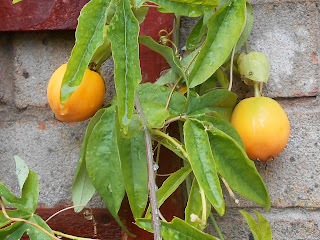The species generally grown in this country is Passiflora caerulea, and this species - in two colour forms - is the plant we grow in our back garden. The specific name of 'caerulea' is generally taken to mean 'sky blue' but apparently the Latin word caeruleus originally meant dark blue or green. The plant illustrated, clothing our garage wall, fails to display either of these colours but, as may be seen, has petals of a delicate pale green.
This plant has fruited prolifically and at the time of writing this blog, bears about twenty of these fruits, each the shape and size of a domestic chicken's egg. This is very pleasing since the plant has been in place for barely a year and is confined to a pot.
The fruits are beginning to ripen; they have reached a golden yellow stage and now look superficially like apricots (Passiflora incarnata is sometimes called Wild Apricot). They may be eaten but sadly they are quite insipid.
Our second specimen is more conventional with regard to colour and is probably in its normal wild form, but his has only produced a couple of fruit. To be fair, it is probably not situated in such a favourable position.
I used the word 'amazing' in the opening paragraph and this is not hyperbole. The passion flowers belong to the family Passifloraceae, of which there are seven recognised genera, but the genus Passiflora, with around five hundred species, is overwhelmingly the largest. I will not try my readers patience with an array of pictures; a survey of the internet will supply that, but I am frustrated that the British climate will not permit them to grow here. I'll restrict myself to one species:
 |
| Passiflora alata, the Winged Passion Flower |
Back to Passiflora caerulea. It is found as a native plant in Argentina and southern Brazil where we presume, frosts are more or less unknown. They are obviously not the passion fruit sold by posh fruiterers but although, as I have said, they are insipid, they may be eaten. However they need to get beyond the 'apricot' stage or they could cause stomach upsets. I won't be tempted.




No comments:
Post a Comment